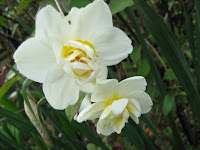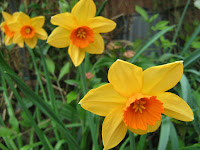Plant Profiles: Daffodils
 |
| A host of golden daffodils: a chance sighting at St James's Park, London in March |
Now there's the opportunity to try again as NAH - in Drastic Gardener guise again - has started to cut back some of the unwanted vegetation (mainly suckering blackthorn and bramble from the public land), thus letting more light onto our patch. The overgrown dogwood still needs taking in hand, but my mind is set on a host of dancing daffodils again.
In the meantime, I've treated myself to some of the daintier ones to cheer next spring. These are mainly in pots, so I can admire them from the patio. I tried this a few years ago and was surprised one evening to find the most amazing scent outside our bedroom window. It was the year of the freakishly warm March and I'd opened the windows wide to cool down. The voluptuous scent of N. 'Thalia' drifting upwards on the air was my reward.
So some more 'Thalia' went on my shopping list, along with 'Jack Snipe', 'Topolino', plus a species one, Narcissus lobularis. I've found the smaller narcissi to be the most rewarding daffodils of those gracing my garden. I also have a large bag of mixed bulbs (a garden centre club member freebie) which I shall add to those I've guerrilla gardened along the public path at the side of the house. Here the more robust, taller varieties rule the roost, making it easy for the residents of the local care home to see when they're taken out for a spot of fresh air.
I love many varieties (see below), and by picking a diverse range their display usually brightens my garden from February to early May... or in the case of last year, from December until May.
Cultivation notes
 |
| 'Geranium' |
The best spot for them is in sunshine, or a place that receives at least 3 hours of sunshine per day. This can include some surprisingly summer-shady spots if the overhead canopy is deciduous. If the leaves have time to die down for 6 to 8 weeks after flowering before the leaf canopy closes overhead, it's worth giving them a try.
 |
| 'Cheerfulness' |
Deadhead spent flowers (so the plant concentrates on food stores rather than seeds) and allow the leaves to die down naturally after flowering. I quickly learned by tying them up or cutting them back to neaten the border was a surefire way to guarantee no flowers next spring. Plants need as much leaf area as possible to help them store sufficient food back in the bulb to power next season's flowering.
 |
| 'Salome' |
Plant firm, healthy looking bulbs; if any of them are soft or have signs of mould, they should be discarded. I've found sprouted ones are fine, as long as the rest of the bulb remains firm. Problems may include slug or snail damage, Narcissus basal rot, and Narcissus bulb fly.
 |
| 'Ice Follies' |
- 'Jetfire'
- 'Geranium' (scented)
- 'Minnow'
- 'Tete a Tete'
- 'Falconet'
- 'Cheerfulness' (highly scented)
- 'St Patrick's Day'
- 'Ice Follies'
- 'Salome'
- 'Pheasant's Eye'
 |
| 'Falconet' |
You can propagate daffodils, but they are usually so plentiful and cheap in the shops, it'd be rude not to buy them. Some varieties are good at propagating themselves - a big clue is when the blurb says 'good for naturalising' or 'clump forming'.
You could also try breeding your own daffodil variety. If this takes your fancy, Lia Leendertz's article on Ron Scamp - daffodil breeding supremo - will be of interest.
You may also like
- Breaking the Rules: Bulbs - in which I explain all is not lost if you - like me most years - don't manage to plant your daffodils this month
- Brightness Amongst Winter's Decay - last winter's record breaking flower count, including my earliest blooming daffodil, ever
- Bunches of Daffodils - one of my favourite views of our estate in spring
- Guerrilla Tactics - evidence of some of my guerrilla gardening
- London Surprises - which shows the bank of daffodils planted by the Tower of London. Imagine a bank like this with some trees and that's how my front side garden will look *crosses fingers*
- Miracle on St David's Day - my Muse Day post which introduces a quite different poem on the theme of daffodils
- The Lent Lily - another poem for Muse Day which uses one of the daffodil's common names
- Tippity Top Daffy Down Dillys - what to look for when buying cut daffodils (always my winter treat), courtesy of some of our fabulous British flower farmers
- University Research Garden - a show garden from RHS Cardiff, which highlights the varied research carried out at the university, including the role daffodils may play in the treatment of Alzheimer's
Further reading:
- The RHS' guide to daffodils, includes pictures of the 13 Divisions used to classify them and how to propagate them if you'd like to have a go
- Wikipedia's Narcissus entry has a lot of information on daffodil taxonomy, habitat, distribution, uses etc.
- Wikipedia's list of daffodils awarded the RHS' Award of Garden Merit (AGM) - seven of my favourites are included, plus 'Jack Snipe' I've just planted
- The American Daffodil Society has a useful website and includes a list of FAQs plus information on exhibiting in the USA. Alternatively, Great Britain's Daffodil Society has been going strong since 1898
- The National Collection of pre-1930s daffodils is held by Croft 16 in Scotland. The best time to view is in April and by appointment. Another part of the National Collection is held by Brodie Castle, a National Trust for Scotland property
- Wordsworth's Daffodils is one of our best-loved poems. Did you know there are two versions of it? No, I didn't either until I wrote this Plant Profile. Wordsworth's Daffodils reveals all...










Interesting, and informative, post. I planted 100 Tete-a-tetes and 50 Thalia on the plot recently. Flighty xx
ReplyDeleteThanks Flighty - it took ages to write, so it's good to know you've found it useful. It sounds like you have a good display in store for next spring :)
DeleteI totally agree about the little daffodils . I live close to the sea, therefore I grow the smaller ones. They don't care about the wind. Thalia is every year in my garden. They flower together with the tulips and make a strong combination. Next week I hope to receive the bulbs I ordered. From that moment it is planting and planting.... succes I hope to see your daffodils next spring. Groetjes Hetty
ReplyDeleteThat's a good point about the smaller daffodils Hetty, they shrug off everything the weather throws at them. *makes note in diary to post daffodil pictures next spring*
DeleteHimself sometimes adopts the guise of 'Drastic Gardener' too :) I'm being restrained this autumn with bulb purchasing but have squeezed in a few more little 'Elka' daffies to plant. Good luck with your would be host of golden daffodils VP.
ReplyDeleteThe host will take a little longer Anna, but it'll be worth it. I haven't come across 'Elka' before, I must check that one out.
DeleteI prefer the diminutive daffodils too for the garden although I have some of the larger cousins on the plot which I can use as cut flowers. Some of the varieties you have mentioned are my favourites too.
ReplyDeleteMy larger ones on the plot have disappeared, though the smaller ones still reward me each year. I thought about growing some for cut flowers, but decided to indulge myself and still buy them as it's a good way to support our British Flower industry
DeleteI had a fantastic comment from K's Garden via my contact form as he had problems commenting via his WordPress account...
ReplyDeleteI'm going through a similar exercise. We have a large area of rough grass
close to the kitchen that I want to be a sea of Daffodils to bring the
cheerfulness of Spring into the house. So I made a shortlist. I wanted to
choose varieties for a long succession, and such that the one going-over
would not contrast garishly with those coming into flower. I stuck to AGM
varieties to narrow it down somewhat ... and whittled it down to ... 28
varieties! So I bought 25 of each thinking I'd then figure out what
actually flowered when, on my soil and in my conditions, and then choose
the 3 or 4 that I actually wanted to plant en masse. I hadn't really
thought about WHERE I might plant all 700 of them! but after sucking on my
pen for a bit I decided that we didn't really have a good Daffodil cutting
bed, short of stealing blooms from the main display areas, so I planted
them in some rough grass that we don't venture to in the depths of Winter.
700 feels like a lot, but a decent vase full is 20 - 30 stems, they last a
week, so with a couple of vases in the house 500 - 1,000 stems over the
flowering period is not that silly - in fact, I might not have planted
enough!
So I started a spreadsheet of when they flower, for how long, how many come
back in subsequent years, and so on. Only got the first Spring behind me,
so I need one more flowering Spring to then decide on the actual short list
for bulk planting.
One you might like to consider is Rijnveld's Early Sensation. If flowers
ridiculously early, although not in the first year from a September
planting, and thus helps to both kickstart and prolong the season.
I'm also going bonkers with a mass planting of Tommmie Crocuses with a mix
of Ruby Giant and some short yellow daffs, like Tete a Tete. But that's
another story ...
http://kGarden.wordpress.com/projects/fruit-and-nut-walk/2/
Hi K and welcome to Veg Plotting :)
DeleteThanks for such a detailed comment, - your trial of what's best for the garden is just the kind of thing I like to do as well. I agree with your estimate on the number of stems you need for a good display and cutting. I originally planted 500 on my bank, which looked magnificent and I could have easily doubled the display without taking any for the vase!
Rijnveld's Early Sensation is on my list - it's planted at West Green House Garden, where I do some online PR work and it looked sensational last year.
I have tommie crocuses too - they multiply fantastically well. Perhaps too well? Troy Scott Smith - HG at Sissinghurst - has had to thin them out drastically as they ran rampant there and prevented other plants from blooming.
I see Kate over at Bean Genie is having problems with her WP blog at the moment, so I hope your problems with commenting here aren't as a result of that.
I mainly look the smaller daffidols too. I love Jetfire too. It does amazingly well in shade. They will flower slightly later in shade than in sun, but they really light up my shady border. Another medium sized one I like is Cragford, which has wonderful scent and flowers for weeks.
ReplyDeleteQuite a few of my Jetfire are in shade too - they really help to brighten it up. I like the sound of Cragford :)
Delete